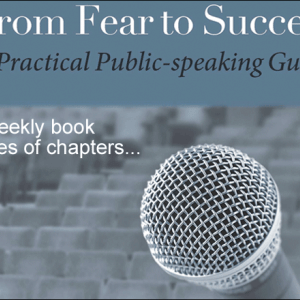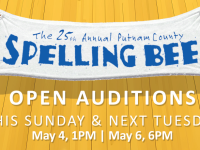Tom Dowd: Road to success, be funny, even though I’m not
Dizzy head. Pounding heart. Shaking limbs. Sweating body. Shallow breathing. Queasy stomach. These symptoms hold people back from what they really want — SUCCESS. Public speakers of all levels will resonate with the concise methods found in "From Fear to Success," an easy-to-read guide to overcome anxiety and relate to any audience on their journey to find their communication confidence.
85. Be Funny, Even Though I'm Not (Audio of this chapter is available here.)
I used to do a monthly presentation at work for newer employees. The topic was often financial fraud, which can be a scary or fascinating topic, depending on how the audience relates to it. I tried to have fun with it to ease the mood and hold the audience members' attention. I started to receive consistent feedback that I was funny and engaging on this potentially complicated topic. I went home and told my wife and she simply said sarcastically, in the way only a spouse could, "You're not funny."
I have retold this story many times and always seem to get some laughs. I do have my funny moments, and it is important to inject humor into your presentations, when possible. Not every presentation is required to have humor, but if you can find a way to appropriately add it in, even during serious presentations, you will give your audience a release and the chance to get more involved in the presentation.
86. Look Around for Humor (Audio of this chapter is available here.)
My personality leans towards being more serious than funny. I have my moments, but I have to work hard to get some laughs. I have concluded that I will never be a stand-up comedian, but I have had more fun with myself, and the audience, once I stopped putting so much effort into being funny. I found all I had to do was remember to just look around me. We are surrounded by humor.
Self-deprecating humor is always a winner and usually won't offend the audience. It can be fun to go back and remember funny and embarrassing stories from your childhood, from school, or from work. You may even begin to chuckle when you unleash the repressed memories. How many times have you sat around the dinner table and rehashed humorous stories with family and friends? After dinner, jot down some notes to help you remember, and throw them in that folder or file.
Look around you. Have you ever passed a sign that made you laugh? I have learned that humor isn't all about one-liners or long, drawn-out stories. The simple stories can get a great reaction. For example, my wife was driving down the road when my fourteen-year-old daughter, at the time, asked her about an old building they had just passed. My wife said that it was an old topless bar. This is the part in the story where people start getting very concerned about appropriateness. You can relax. My daughter asked, "What did they do when it rained?" We are surrounded with funny life moments.
87. Find the Funny Soon (Audio of this chapter is available here.)
Comedians use quick-hitting humor and one-liners because they don't want to lose the audience. They work on timing and delivery to get the biggest laughs. I learned that not everything a speaker says needs to be side-splittingly funny. Going for a few chuckles can be just as entertaining to an audience. You simply need to know what your audience wants and expects.
Once you determine this, you can develop your humorous stories. As with a quick-hitting comedic set-up, you must get to the humorous part of the story sooner rather than later. I have watched speeches crash as the audience knew something funny was coming but it took too long to get to the punch. I was involved in a humorous-speech competition, and four of the first seven contestants went several minutes into a five-to seven-minute speech before they delivered their first laugh. Don't get me wrong. My fellow competitors were hilarious once they got rolling, but they had unfortunately lost many of the judges and audience members, who were expecting the funny parts sooner. Don't let the audience wait too long to laugh.
88. Let the Audience Know It's Okay to Laugh (Audio of this chapter is available here.)
I was practicing a very serious speech for the first time in front of a co-worker. It was very personal and emotional. However, in a couple of spots I attempted to add some levity, to ease the seriousness of the message. I saw no reaction to my attempts at humor. After the speech, I asked my co-worker if it was inappropriate, ill-timed, or just not funny. She said she thought it was funny but she wasn't sure, given the heavy weight of the message, if she was allowed to laugh.
The speaker needs to give some indication, whether it is a wink or a smile or some other kind of non-verbal or verbal "permission," for the audience to come along on their journey. A well-placed pause, for example, with an emerging smile may be enough to connect with the audience and let them know it's okay to laugh.
89. Exude Energy—It's Contagious (Audio of this chapter is available here.)
Have you ever had a presenter stand in front of you and lethargically say, "Hi, my name is John, and I'm really excited to be here." My first thought is always a sarcastic, "It looks like it." What am I supposed to look forward to as someone in the audience? Energy is contagious, and the audience needs to feel the passion and enthusiasm you want to share with them. Your ability to genuinely exude your hunger and to motivate and inspire your audience will get the group hungry to receive your message. Words without energy are just words without meaning—until you bring them to life.
90. Be Sincere — It Means More Than Words (Audio of this chapter is available here.)
You can have the most thoughtful and powerful words ever written, but if they don't come from your heart, they will land flat. Always give your audience credit for the ability to see through speakers who may not believe in what they're talking about. Your own credibility is at stake, and your ability to show the real you, including your personality, values, and beliefs, will always connect with an audience.
At times you may want to exaggerate a point, to set the tone or to get the audience to visualize the message. Many public-speaking books say that it is acceptable to stretch the facts a little to ensure that the significance is grasped. However, even with tall tales or embellished stories, you have to show that you, yourself, believe them and can execute them with burning passion because they are coming from your heart and soul. An audience may not always agree with your points or message, but they must always believe it is the real you.
91. Emphasize Physical Aspects in the Speech (Audio of this chapter is available here.)
We hear "public speaking" and obviously think about the spoken words. We invest a lot of time as speakers in selecting the perfect word for the perfect situation. As we prepare and practice, we should remember to work on the complete package, beyond memorizing the words and vocalizing. In our speech development, we sometimes lose the physical aspects of the speech that can make the presentation come alive.
Physical aspects of the speech include facial expressions and gestures. Imagine a speaker sharing a "shocking" story with a blank look on his or her face. Like a punch line in comedy, you need your face and body to emphasize the emotions of the words to bring them alive. In the "shocking" example, you would probably expect wide eyes or a gaping mouth. Let the audience share the experience with you. Your facial expressions may not even need words if your feelings can be seen and related to by the audience.
Gestures are also important in moving the speech along, and you must remember both the importance of timing and the naturalness of the movements. You don't want your movements to come across as staged or prescribed. Although practicing the gestures to get them to the point where you want them is imperative as you put the whole package together, you do not want them to come across as acting. The physical aspects of the speech are one more way to look at the speech process holistically.
92. Go Big (Audio of this chapter is available here.)
You might ask the audience for a response and tentatively raise your hand in the hopes that they will, too. However, the tips of your own fingers may not even go above your head. How will the audience react? They, too, will be reluctant to raise their hands because they are taking their cues from you. Go big with your gestures. You should let it out like you mean it. This doesn't mean going so far outside of your own comfort level that you are not being genuine, but understand that the audience needs to see the energy and enthusiasm of an effective gesture.
The audience wants to get the most out of the physical and non-verbal aspects of your speech. If you are giving a sly smile, don't make it quick. Give a pause with the slow emergence of a smile so the audience gets the full effect. A friend of mine who is an experienced swimmer always talks about the full extension of the fingertips through the water. The same concept should apply here with your gestures, vocals, and any other pieces of the speech that can stir the audience. In a speech, if you mention being a sprinter in a race, take a few quick, bursting steps. You should fully embrace the emotion you want to evoke in the audience. The audience should definitely know how you are feeling and what you are doing—don't make them guess or assume. Their ability to view and immediately grasp your every move will enhance their engagement, involvement, and understanding.
93. Turn Off the Lights and Watch Them Snooze (Audio of this chapter is available here.)
Speakers turn off the lights for many reasons. One of the obvious is that the need to see presentation slides clearly. As you have read, you will want to minimize your dependence on slides, when possible, and also have the font big enough that the audience doesn't need to strain, which may, in turn, allow for just dimming the lights or even keeping them on altogether. Personally, I turned off the lights in my early public-speaking experience because of the blotchiness on my neck and face that I didn't want seen. I also suspect that I didn't want to look the audience in the eyes. I might also add that I often accomplished that mission because audience members' eyelids would close when the darkness came. Just think back to any school experience when the teacher turned down the lights to show a movie, for example, in class.
When the lights go down, the comfort level of the audience goes up. Regardless of how engaging you are, you will always fight audience drowsiness. If you do need to project a presentation, do it in short spurts, or simply turn the lights down, but not off. If there is background lighting, try to use that. If you must turn off the lights, try using interactive responses from the group to keep them focused on the message. Don't disengage the audience by putting them in the dark.
94. Share Emotions (Audio of this chapter is available here.)
We all laugh, cry, and even scream when we see something scary. Have you ever noticed that laugh tracks are included in many sitcoms on television because laughter is contagious? Everyone does it. David Brooks, the 1990 Toastmasters World Champion of Public Speaking, shared a story on his "Dave's Top Ten Techniques Every Speaker Should Know" CD about an article in the Austin American Statesman (LM Boyd's "Trivia" column) that mentioned that we all share the same emotions: happiness, sadness, anger, surprise, disgust, and fear. As we search high and low for stories that can hit the mark, maybe we don't have to look so hard. Simple stories can touch one of the emotions listed above and are guaranteed to relate to the audience in some way. As you share your emotions, you will see members of the audience thinking of a similar time when they felt the same emotion. Sharing emotions instantly connects you to the audience.
Related links:
• Chapter 1: Step into the public forum
• Chapter 2: Find the sources of stage fright
• Chapter 4: Understand that success is possible
• Chapters 5-14: Road to success, the anxiety
• Chapters 15-24: Road to success, don't let personality be an excuse
• Chapters 25-34: Road to success, paint the picture
• Chapters 35-44: Road to success, set your stage story
• Chapters 45-54: Road to success, appreciate the audience’s diversity and differences
• Chapters 55-64: Road to success, brainstorm, the friends-and-family effect
• Chapters 65-74: Road to success, grab attention with your opening
• Chapters 75-84: Road to success, use notes — or don’t
 Tom Dowd has spoken at many of the Midcoast Rotary, Kiwanis and Lions clubs, is a member of the U.S. National Toboggan Championships Committee, and announcer of the event. He lives in Camden with his wife and three daughters. To read his full biography, click here. He can be contacted at transformationtom.com or tomdowd@roadrunner.com. Follow Tom on twitter: @TomDowd4; connect on Facebook at Thomas Dowd Professional Development & Coaching; and on Linkedin, listed as Thomas B Dowd.
Tom Dowd has spoken at many of the Midcoast Rotary, Kiwanis and Lions clubs, is a member of the U.S. National Toboggan Championships Committee, and announcer of the event. He lives in Camden with his wife and three daughters. To read his full biography, click here. He can be contacted at transformationtom.com or tomdowd@roadrunner.com. Follow Tom on twitter: @TomDowd4; connect on Facebook at Thomas Dowd Professional Development & Coaching; and on Linkedin, listed as Thomas B Dowd.
Event Date
Address
United States
























